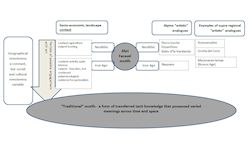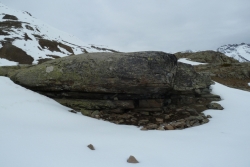
Based on the comparisons presented earlier, we might plausibly assign the art either to the Neolithic or the Iron Age. In both chronological contexts, forms of tacit knowledge would have influenced the production and 'reading' of such motifs. Moreover, such forms of knowledge could have informed engagements with, or readings of, these motifs during periods that post-date the production of the paintings (Figure 22). For both periods, landscape context constitutes a fundamental quality that will have influenced reasons for the production of the paintings, and subsequent readings or roles of these images.

The fact that we have rock art at high altitude requires that we define and exploit our understanding of this specific and unusual socio-economic/ecological context. Whereas the environmental context will not have changed significantly between the Neolithic and Iron Age, the socio-economic and ideological frameworks for these two periods would have been rather different. However, for both periods, this art could have signified, or codified, forms of environmental knowledge. Such knowledge or information would have been an element within understandings of alpine vertical ecology, and associated cycles of activity.
First, all human activity and the formation of culture are influenced by environmental variables, and activity in mountains is thereby constructed via understandings of the different environmental characteristics of the vertical zones – from valley bottoms, via alpine plateaus, to mountain passes and summits (Walsh 2014, chapter 8; Walsh et al. 2014). As the still images and virtual model of the landscape illustrate, the area is both remote and surrounded by peaks and ridges that may well have acted as important cultural markers for those who lived and worked in this area. It is more than likely that the rock shelter was important as a settlement site, with both utilitarian and symbolic values. Utilitarian, as a rare but welcoming natural shelter in this exposed environment, the Abri Faravel was literally the only natural shelter in the area, even offering protection from snow (Figure 23). These utilitarian characteristics may well have engendered the emergence of symbolic value as a refuge bestowed upon this often hostile landscape. Ethnographic research demonstrates how these notionally discrete categories (utilitarian and symbolic) often intersect, operating as hybrids in many societies (Descola 2006; Latour 1997). The presence of the paintings perhaps added to the degree of protection provided by the shelter.

Other alpine sites, such as the Grande Rivoire rock shelter (Isère, France), reveal the continued dominance of red deer as the hunted species across the Mesolithic and Neolithic, with domesticates entirely absent from the Grande Rivoire Neolithic faunal assemblages (Nicod et al. 2012). In addition, red deer constitute more than 30% of the animal bone in faunal assemblages from a number of northern Italian Middle Neolithic sites, and on occasion (such as the site Molino Casarotto), deer bone is by far the dominant category (Boyle 2014). At Faravel, the archaeological and palaeoecological evidence allow us to suggest that the plateau was an ideal hunting ground; a number of lithic scatters suggest hunting activity during the Neolithic, and palaeoecological evidence reveals little in the way of pastoral activity at high altitude. We know that red deer were present across the Alps and undoubtedly easier to hunt beyond the treeline. If we accept that rock art is in some ways tied to the subsistence activities (i.e. the art was produced by hunters (for an ethnographic example see Raa 1971) or pastoralists), then such art is a form of socio-ecological production, where elements of the non-human world are emphasised. However, forms of underlying tacit knowledge – acceptance of what motifs should or could be reproduced, may well have restricted the scope for choice of what these hunter/pastoralist-'artists' produced. At Faravel the deer is emphasised as prey, not simply as game. The red deer facing (off) a dog association possibly echoes animal taxonomy; we can see a contrast/confrontation between two animal categories based on their proximity to, or relationship with, humans – deer as prey, dogs as partners in the hunt. Such a confrontation could refer to a division or categorisation of certain environmental characteristics or, more specifically, the world of non-human animals. We should also consider which category of person (a shepherd, a specialised hunter, or itinerant artist) produced these paintings, and what their motivation was.
We might also infer the seasonal context for the animal composition, as deer would probably have had full antlers during the summer, with fawns born during the spring and undoubtedly present in the high-altitude zones during the summer hunting season. It is possible that the seasonal or temporal meaning associated with the motif is unimportant, and that the deer is merely an idealised representation that ensures that the sex of the deer (i.e. male) is apparent. This emphasis on the male of the species echoes images from other regions (referred to in other sections), suggesting a collective notion of what should be represented (Sperber 1999). Furthermore, on a number of European sites, the adult sex ratio in the faunal assemblages suggests the selective hunting of males (Russell 2011, 271). As already noted, the site was probably at the timberline, or tree line; a 'strategic' point, an interface between different environments or topographic zones. The sets of painted parallel lines at the Abri Faravel might represent trees. This form of motif might have signified conventions vis à vis where and when hunting should take place. The fact that part of the composition at Faravel represents a 'hunting scene' does not mean that the artists themselves participated in hunting. Moreover, we have to accept the possibility that the images did not constitute hunting instructions per se, but were a form of territorial marking, articulated via a motif that was universally understood; ultimately we should consider that 'People depict animals because they are food for thought rather than just food…' (Russell 2011, 14).
The orientation of the animals is another 'rule' that might have been followed – most deer representations from across the region, including that at Faravel, have their heads towards the right. Moreover, the lateral or horizontal organisation of the motifs suggests that they were painted from the outer zone of the rock shelter, and so were meant to be viewed from this area. The fact that this art is situated on the ceiling of a rock overhang does suggest that the painting was 'hidden', with viewing only possible from under the overhang. However, the dearth of suitable surfaces for painting suggests that the painter/s might not have intentionally concealed their work. In addition, the fact that we have a number of phases of activity, through to the Middle Ages, suggests that a number of people have been aware of these paintings, and interestingly, never added to them, nor defaced them. These pre/proto-historic messages were possibly shared, or universally understood; in many ways quite different from post-medieval and modern rock art, where the engravings are often personal; names of shepherds and depictions of the shepherd with their dog, and sometimes associated with images of flowers and the mountains.
For our Neolithic context, we can consider the notion that low-altitude agricultural landscapes were imbued with meaning via tombs and other monuments, where encounters with ancestors were controlled (Thomas 1990, 175). This local zone, where human-landscape interactions were frequent, where ancestors were ever-present, thus structured relationships with that landscape. However, distant landscapes, including the high Alps, without obvious human-made monuments associated with ancestors, must have been perceived in a very different way. The Neolithic flint scatters across the plateau, and the palaeoecological evidence for agriculture towards the valley bottoms, suggest that hunters frequented this high-altitude zone. Such margins may well have been considered as an obscure, although valued, tier within the Neolithic world. It is likely that a distinction between inhabited 'domesticated' zones (the valley bottoms) and the less-frequented high alpine 'wild' areas was operative, even if a simplistic domestic/wild dichotomy is problematic (Descola 2005; Héran 2007). From the Middle Neolithic onwards, we have to question the notion of hunting taking place in 'non-domesticated' spaces, as pastoralists started to exploit these zones above 2,000m – we might consider the notion of 'semi-domesticated' spaces; agricultural-pastoral-hunting hybrid landscapes that would have possessed many layers of meaning. If the paintings are indeed Neolithic in origin, then it is more than likely Bronze Age occupants at the shelter saw them. While this period witnessed the development of a pastoral landscape, it would be wrong to assume that pastoralism and hunting were mutually exclusive activities, and the motifs may well have been read as representing the tradition or practise of hunting in this landscape. These rock art motifs across the Alps, and other parts of Europe, should be seen as part of the network of phenomena that reflect the social importance of hunting in farming societies (Hamilakis 2003). Whereas the art in areas like Val Camonica and Mont Bego comprise a great variety of motifs (Arcà 2004a), art in other parts of the Alps is comprised of a restricted number of motifs. Scenes with male deer, and especially hunting of deer, are the most persistent motif in these zones.
We have already declared that an Iron Age date is a possibility for the production of the motifs at Faravel. Therefore, we now need to consider the associated archaeological and landscape context for this period. As noted elsewhere, while there is a noticeable dearth of archaeological sites dated to the Iron Age across the Faravel plateau, the palaeoecological evidence implies a continuation of pastoralism at high altitude. Consequently, the environmental and economic contexts were in many ways similar to those during the Neolithic. However, a different social or cultural framework would probably have imbued the motifs with quite different meanings. It is probable that hunting, and its depiction via art was a male activity, as the study of central Alps chalcolithic stelae suggests for earlier periods (Defrasne 2013), and as evidenced by male figures engraved in Iron Age hunting scenes (at Naquane, Roccia Grande, Val Camonica for example). As Hamilakis suggests, '…we may be seeing the contestation between two different logics/perceptions of space and time: one in which authority and power were perhaps justified on the basis, amongst other things, of the links with the familiar place and with ancestral time, and another competing one (Chapman 1994, 83), which might have emphasised a break with the familiar, and a disruption of ties with the ancestral locality, and valorised the encounter with the distant and the unfamiliar' (Hamilakis 2003, 243). This characterisation is perhaps appropriate for our Iron Age assessment of the art – a social context where hunting and feasting amongst social elites seems to have been common. For example, deer dominated the animal bone assemblage from the Les Sagnes 'tertre' (a burnt mound at 1,900m) in the Ubaye Valley, to the east of the Ecrins. The minimum number of individuals identified were: 3 wild boar, 5 cattle, 20 pigs, 33 sheep and 47 deer (Columeau 2003; Garcia et al. 2007; Walsh 2008). Consequently, there are a number of categories of evidence that support the notion of conceivably ritualised, elite, hunting activities during the Iron Age.